Are you looking to elevate your outdoor space with a touch of creativity and style? A 12×12 paver patio might be just what you need. These versatile, durable, and cost-effective outdoor flooring solutions offer endless possibilities for creating a stunning relaxation area or entertaining space.
In this comprehensive guide, we’ll explore 17 innovative paver patio ideas that will inspire you to transform your backyard into a personal oasis.
The Magic of 12×12 Paver Patio
Before we dive into the specific designs, let’s understand why 12×12 paver patios have become increasingly popular among homeowners and landscape designers.
The Allure of 12×12 Pavers patio
12×12 pavers offer a perfect balance between size and manageability. They’re large enough to create a bold visual impact but small enough to allow for intricate patio patterns. This size is particularly well-suited for:
- Creating a sense of spaciousness in smaller yards
- Establishing a strong visual foundation in larger outdoor areas
- Facilitating easier installation compared to larger pavers
Versatility in Design and Function
One of the greatest advantages of 12×12 pavers is their versatility. They can be used to create:
- Cozy seating areas
- Elegant outdoor retreats
- Functional entertaining spaces
- Charming garden designs
Cost-effectiveness and Durability
Durable pavers are an investment in your home’s value and your long-term enjoyment of your outdoor space. 12×12 pavers patio offer:
- Long-lasting beauty with proper maintenance
- Resistance to cracking and weathering
- Easy replacement of individual pavers if necessary
Now, let’s explore the 17 stunning designs that will help you create your dream patio.
Classic Patterns with a Twist
1. Elevated Square Pattern: Adding Depth with Varying Shades
The classic square pattern gets a modern upgrade with this design. By using pavers in varying shades of the same color family, you can create depth and visual interest without straying from the traditional layout.
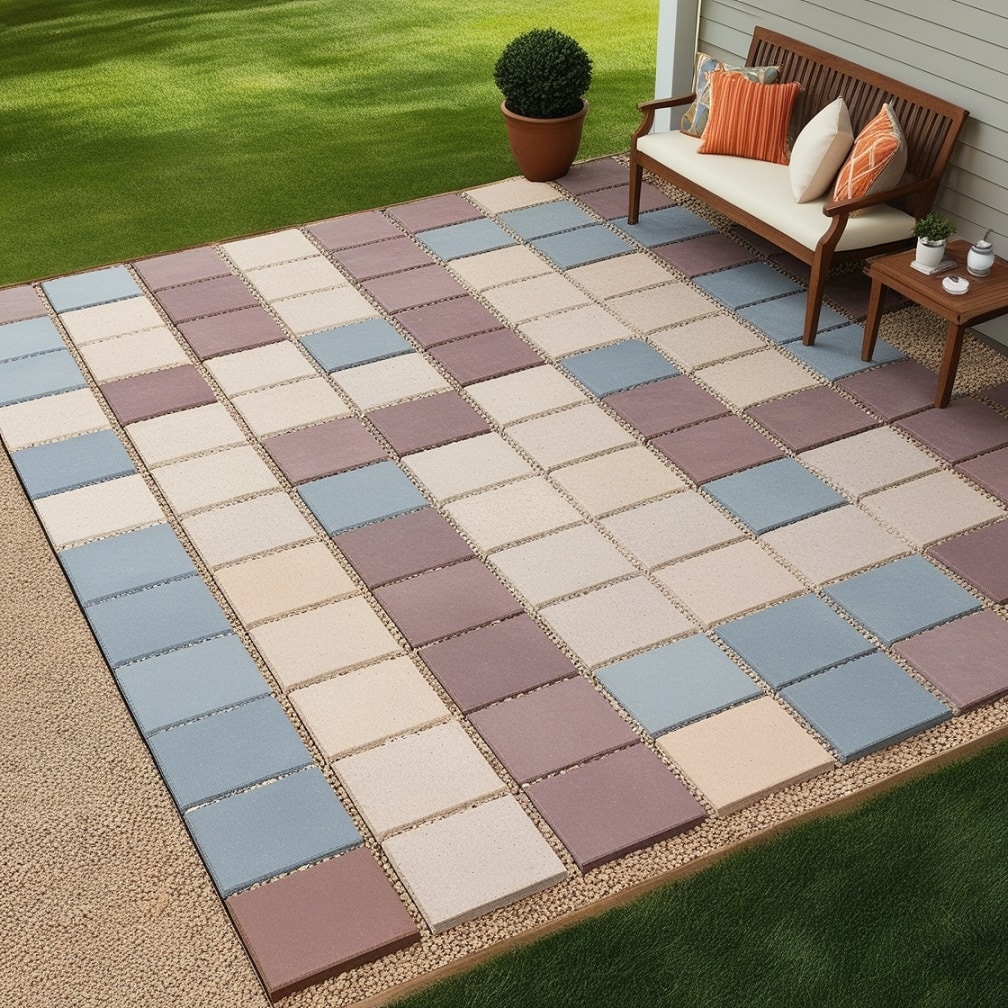
“The key to an elevated square pattern is subtle variation. Think ombre effects or gentle gradients that guide the eye across the patio.” – Sarah Johnson, Landscape Architect
Installation steps:
- Measure and mark your 12×12 patio area
- Prepare the ground and lay a gravel and sand base
- Start from one corner, placing pavers in a grid
- Alternate shades as you go, creating a gradient effect
- Fill gaps with sand and compact
Transform your garden into a stunning masterpiece with Beuta Landscape Edging – click to explore this perfect blend of style and durability on Amazon now!
Transform your outdoor space effortlessly with Goovilla’s waterproof, interlocking deck tiles – perfect for patios, pools, and balconies. Explore now on Amazon!
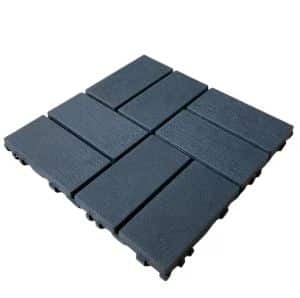
2. Herringbone Harmony: Incorporating Contrasting Border Tiles
The herringbone pattern is a timeless choice that adds sophistication to any outdoor space. By adding contrasting border tiles, you can create a framed look that elevates the entire design.

Materials needed:
- 12×12 pavers for the main area
- Contrasting pavers for the border (consider using 6×6 or 6×12 for easier corners)
- Sand and gravel for the base
- Edging material
Pro tip: For a truly striking look, consider using a bold color for your border tiles, such as charcoal against light gray pavers.
3. Circular Sensations: Blending Curves with Straight Edges
A circular design doesn’t mean you have to give up on your 12×12 pavers. This innovative approach combines the structure of square pavers with the fluidity of circular patterns.
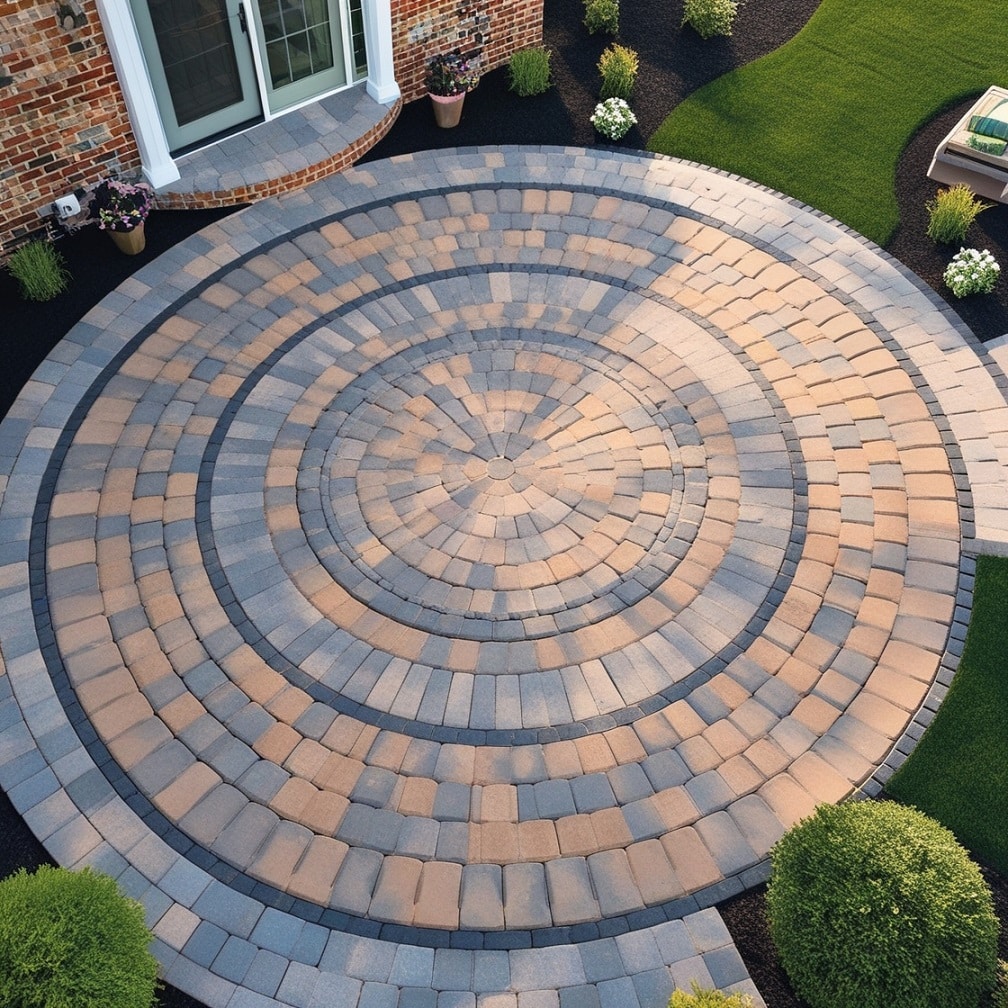
Steps to achieve this look:
- Create a central circle using cut pavers
- Radiate outward with full 12×12 pavers
- Fill gaps with smaller cut pieces
- Surround the circular area with a square or rectangular border
This design is perfect for creating a focal point in your outdoor retreat, perhaps surrounding a water feature or fire pit.
Geometric Marvels
4. Modernist Checkerboard: Playing with Scale and Color
The classic checkerboard pattern gets a contemporary makeover in this design. Instead of the traditional black and white, consider:
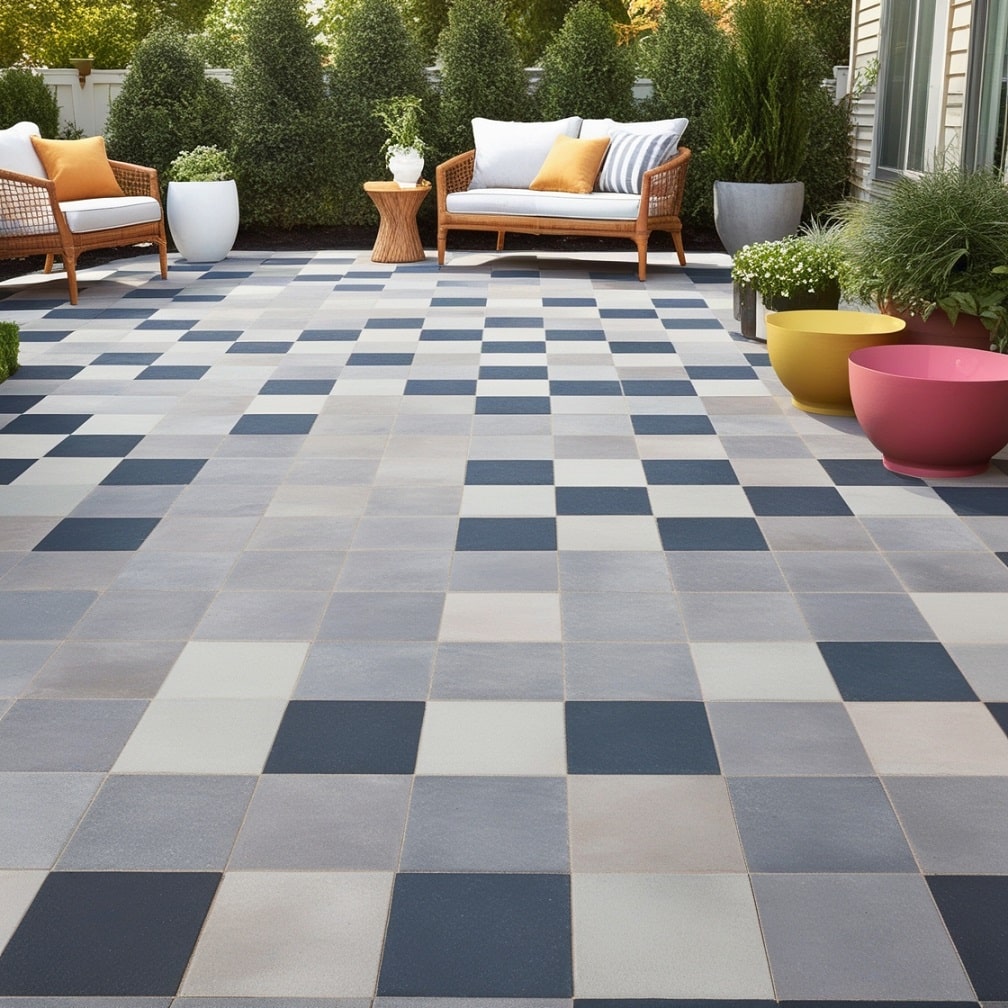
- Shades of gray for a subtle, sophisticated look
- Earth tones for a natural, rustic feel
- Bold colors for a playful, modern vibe
Design tip: Incorporate larger ‘squares’ by grouping four 12×12 pavers together before alternating colors.
5. Intricate Basket Weave: Mixing Textures for Visual Interest
The basket weave pattern is a favorite for its interlocking design that adds visual texture to your patio. To elevate this classic look:
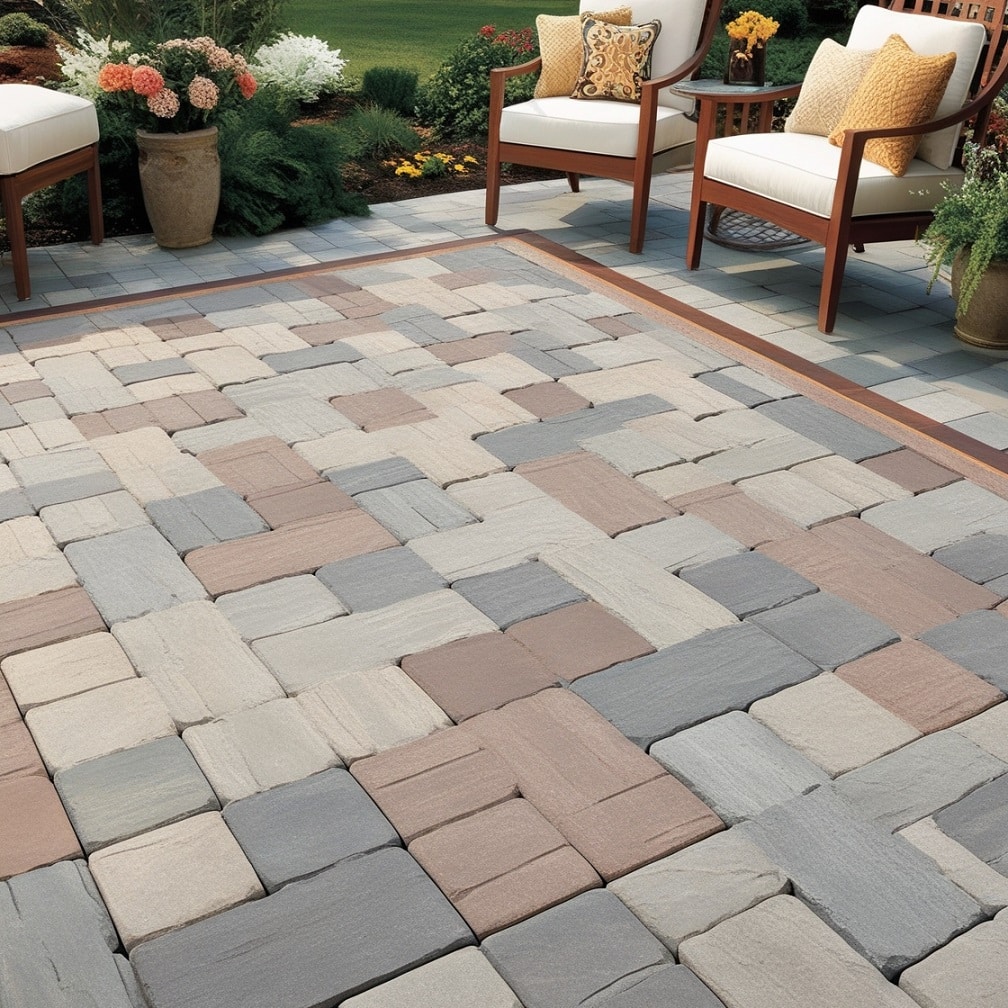
- Mix smooth and textured pavers
- Incorporate two complementary colors
- Add a contrasting border to frame the design
Table: Texture Combinations for Basket Weave Patterns
| Texture 1 | Texture 2 | Border |
|---|---|---|
| Smooth | Brushed | Tumbled |
| Polished | Matte | Textured |
| Stamped | Plain | Contrasting Color |
6. Dynamic Diagonal Layout: Creating Movement and Flow
A diagonal pattern can make your patio appear larger and more dynamic. This layout works particularly well in smaller spaces or as a pathway leading to a larger patio area.
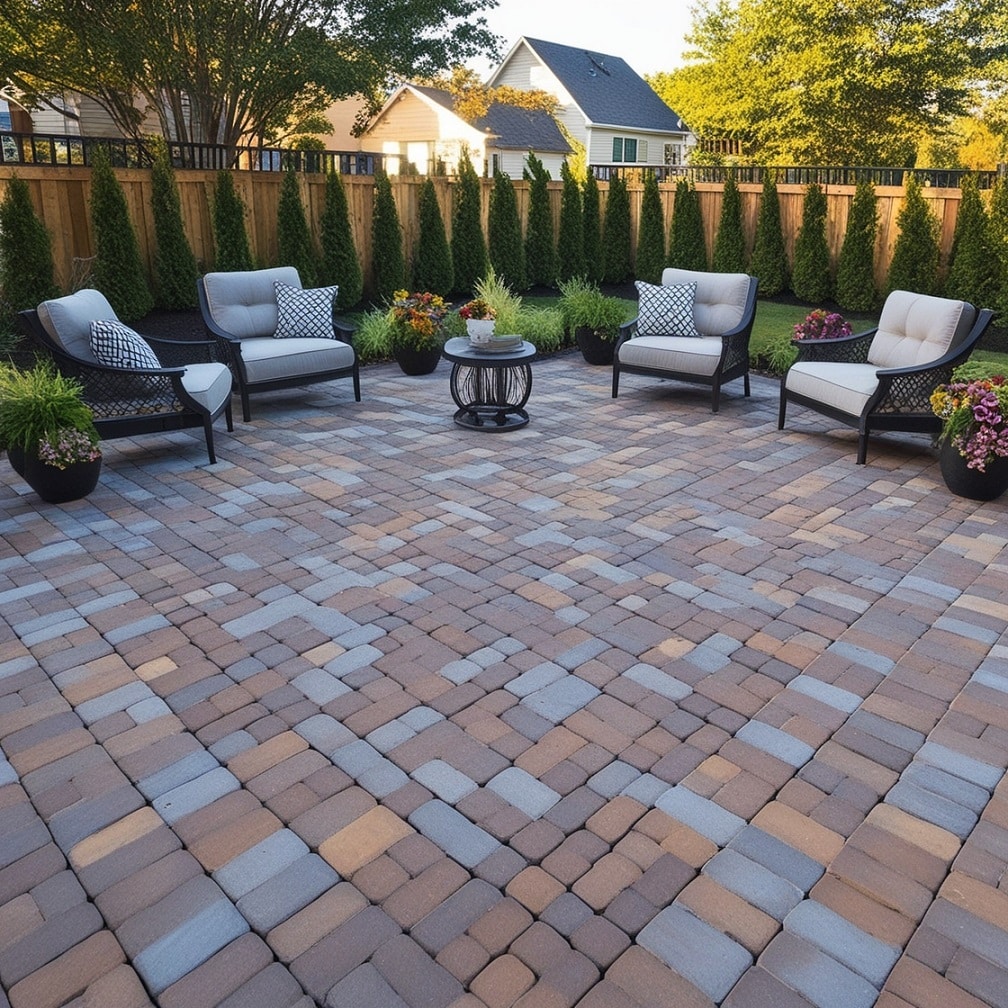
Benefits of diagonal layouts:
- Creates an illusion of more space
- Adds visual interest and movement
- Works well with both modern and traditional home styles
Pro tip: Use a contrasting grout color to emphasize the diagonal lines and create a more defined pattern.
Natural-Inspired Designs
7. Organic Random Stone: Mimicking Nature’s Patterns
For those who love the look of natural stone but prefer the durability and cost-effectiveness of concrete pavers, the random stone layout is ideal. This design mimics the organic patterns found in nature, creating a rustic and timeless appeal.
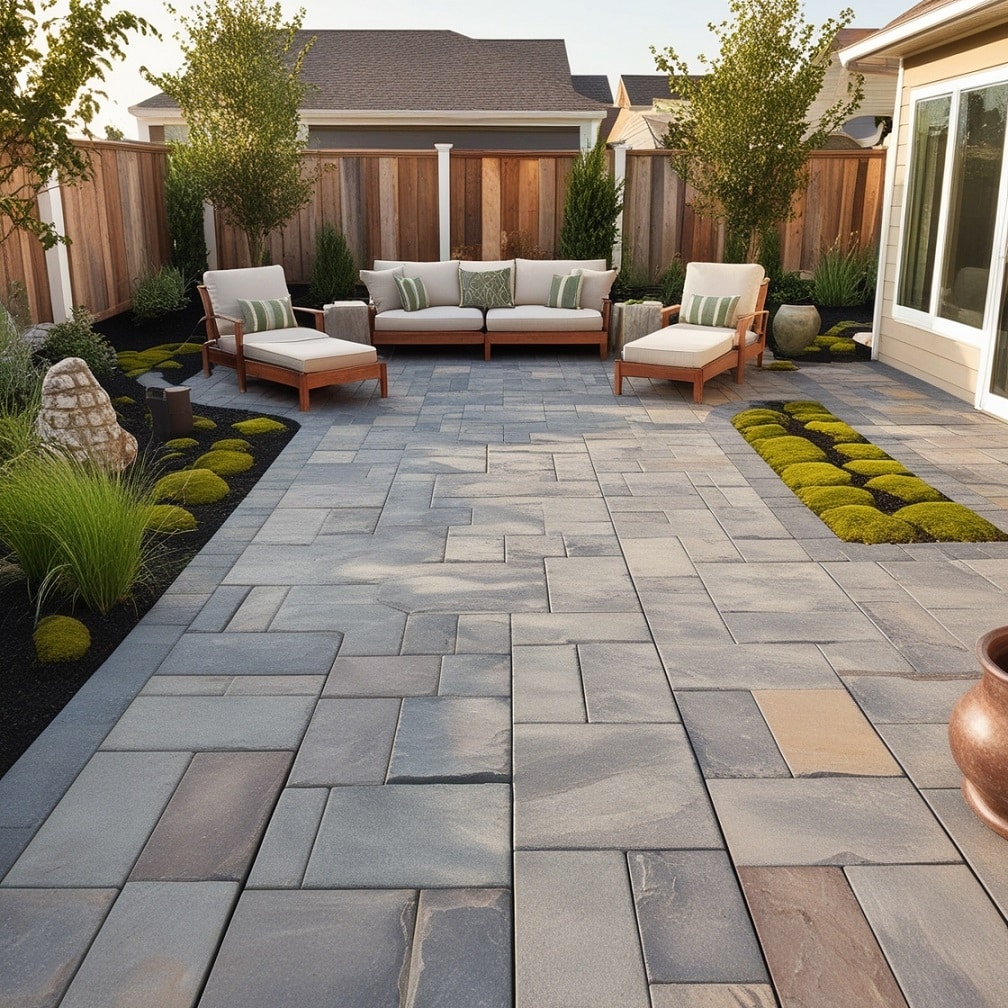
Steps to achieve a natural look:
- Choose pavers with irregular edges or those that mimic natural stone
- Lay pavers in a seemingly random pattern, avoiding obvious repetition
- Use smaller pieces to fill gaps
- Consider adding moss or small plants between pavers for added authenticity
8. Riverbed Effect: Integrating Pebbles and Larger Pavers
Create a stunning visual effect by combining your 12×12 pavers with smaller pebbles or river rocks. This design evokes the feeling of a dry riverbed, perfect for a zen-inspired garden design.
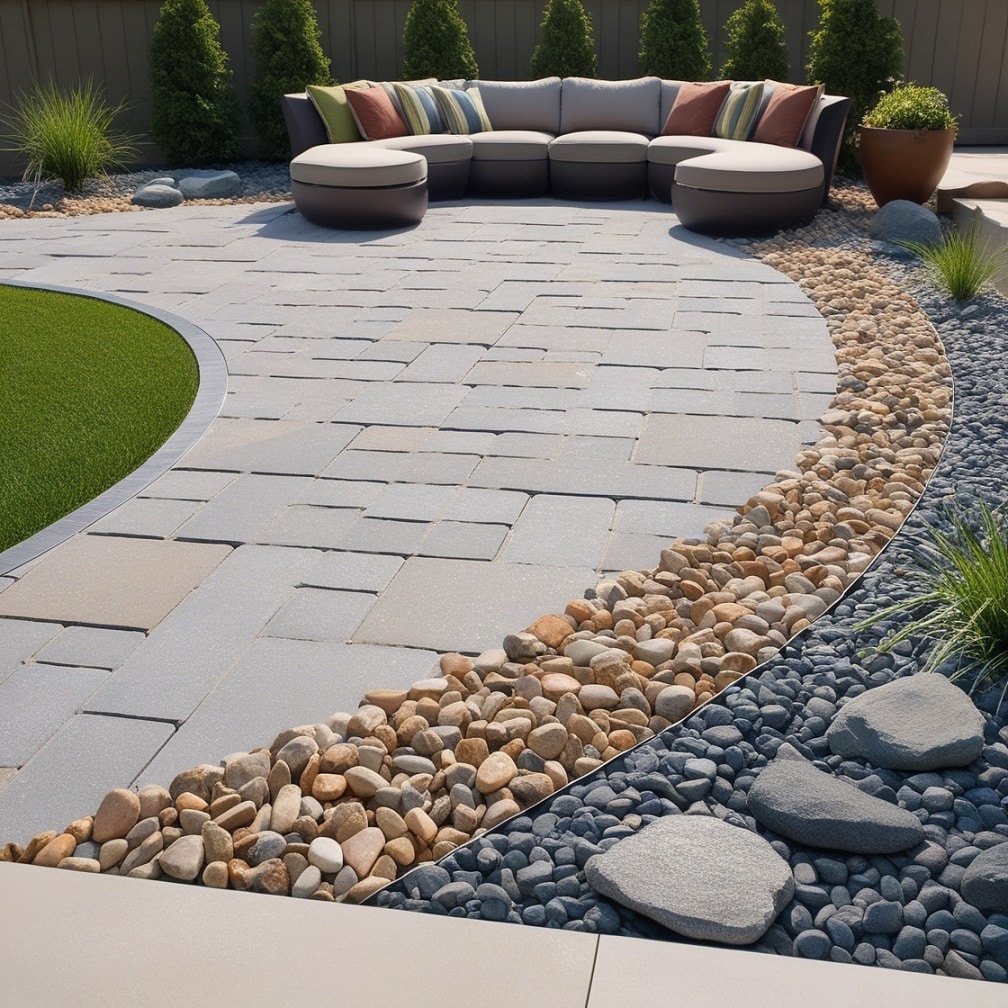
Materials needed:
- 12×12 concrete or natural stone pavers
- Pebbles or river rocks in varying sizes
- Landscape fabric to prevent weed growth
- Edging material to contain the pebbles
“The key to a successful riverbed design is in the flow. Arrange your pavers to create a winding path through the pebbles, mimicking the natural course of a river.” – Michael Chen, Landscape Designer
9. Faux Wood Planks: Achieving Warmth with Concrete Pavers
For those who love the look of wood but want the durability of concrete, faux wood plank pavers are an excellent choice. These pavers mimic the texture and color of wood but offer the longevity and low maintenance of concrete.
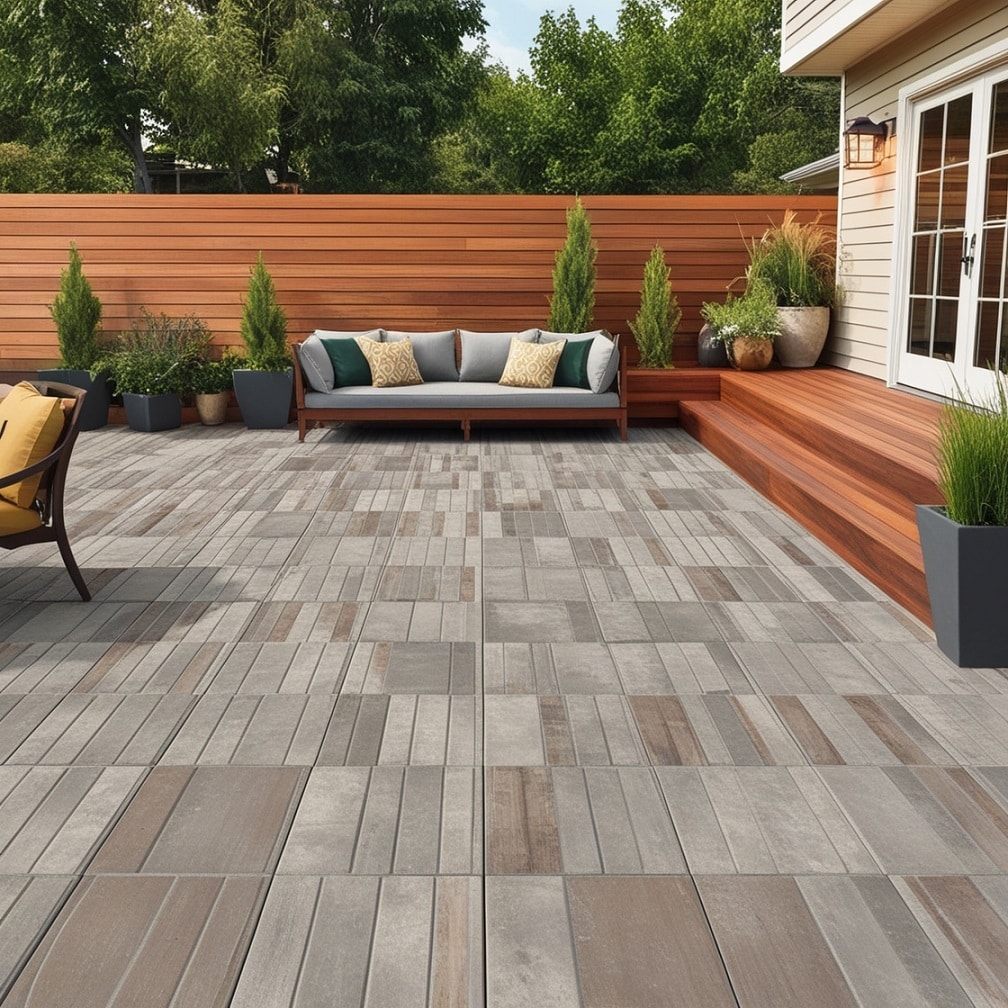
Benefits of faux wood pavers:
- Resistant to rot, insects, and weathering
- No staining or sealing required
- Available in a variety of wood tones
Design idea: Create a herringbone or basket weave pattern with your faux wood pavers for a truly unique look that combines the warmth of wood with geometric precision.
Artistic Expressions
10. Mandala Mosaic: Centering Your Patio with a Focal Point
Transform your patio into a work of art with a mosaic design inspired by mandalas. This intricate pattern serves as a stunning focal point and conversation starter.
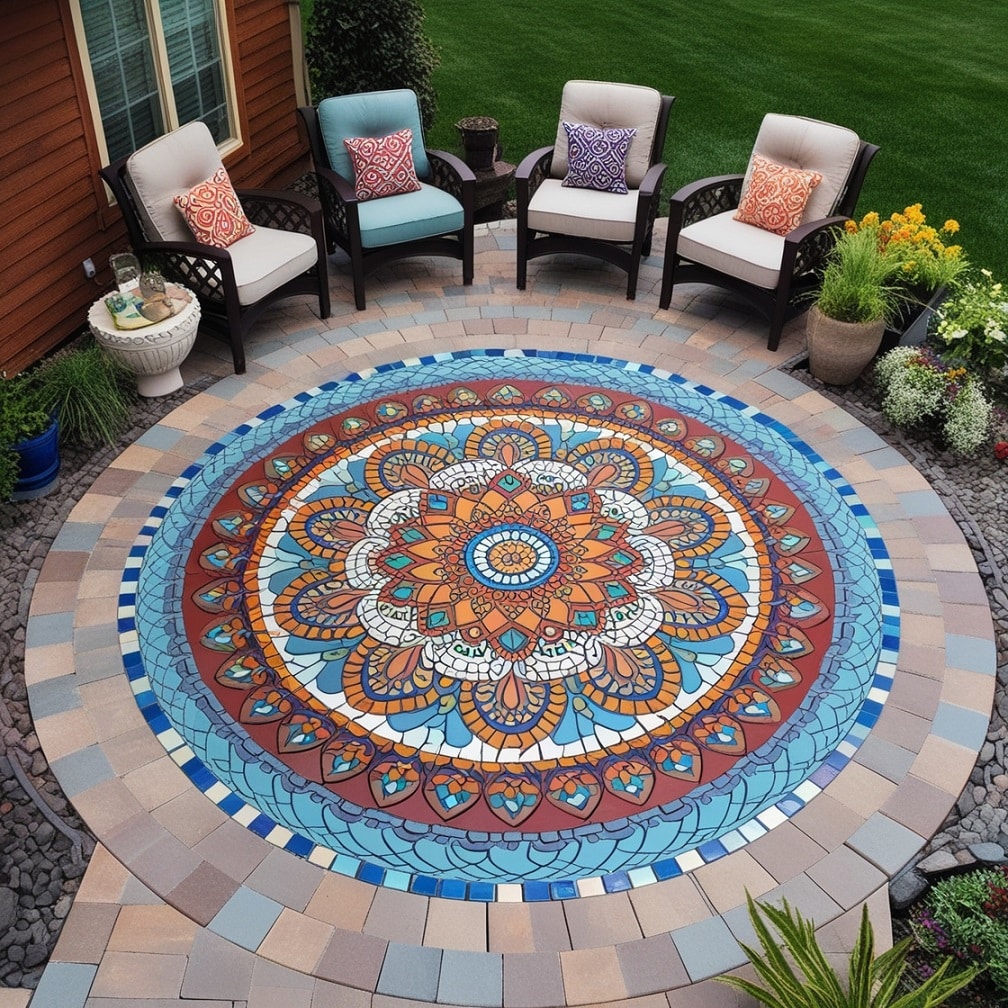
Creating a mandala mosaic:
- Design your mandala pattern on paper first
- Use different colored 12×12 pavers as your base
- Cut smaller tiles or use mosaic pieces to create the intricate designs
- Consider using glow-in-the-dark tiles for sections that will illuminate at night
11. Sunburst Spectacular: Radiating Design from a Central Point
A sunburst pattern creates a dramatic effect that draws the eye to the center of your patio. This design works particularly well for circular or octagonal patios.
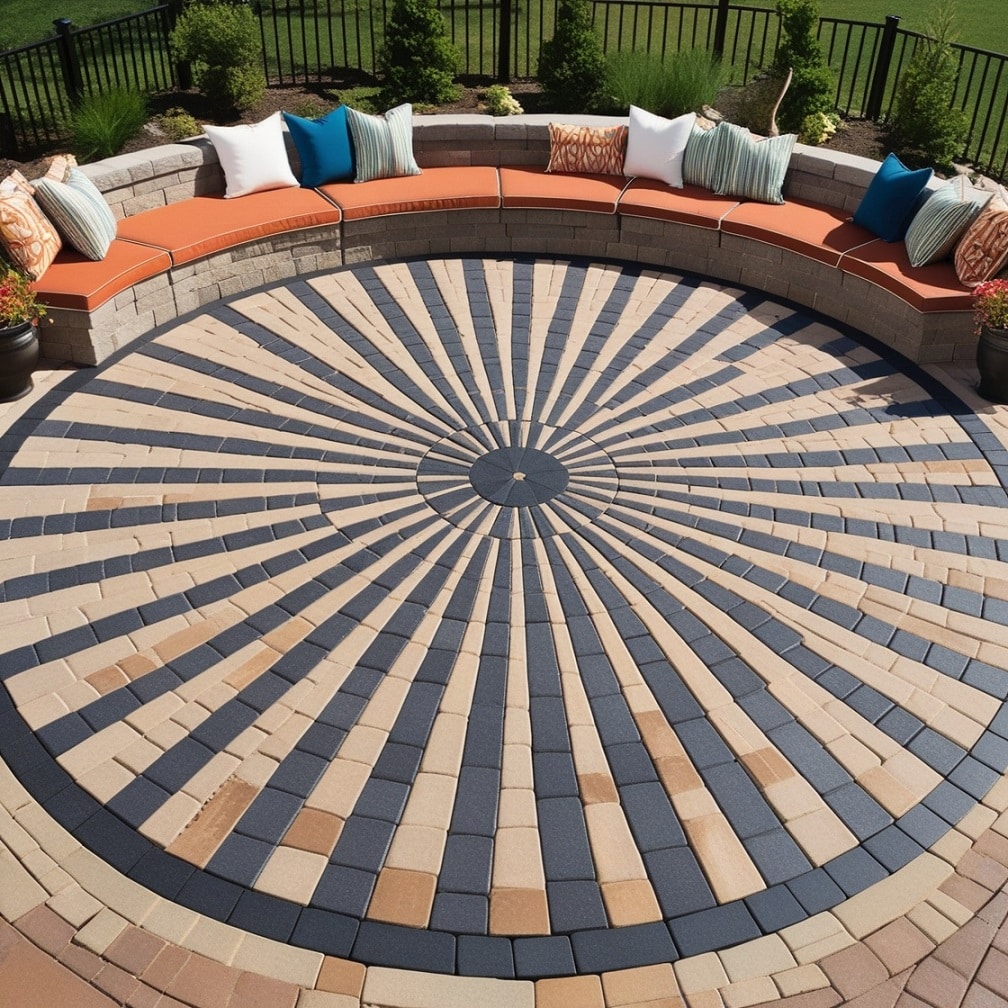
Steps to create a sunburst pattern:
- Determine the center point of your patio
- Lay full 12×12 pavers in a radial pattern from the center
- Cut pavers to fit as you reach the edges
- Consider using contrasting colors to emphasize the radial design
12. Yin and Yang Balance: Contrasting Light and Dark Pavers
Create a harmonious balance in your outdoor space by incorporating the principles of yin and yang into your patio design. This involves using contrasting light and dark pavers to create a sense of balance and flow.

Design ideas for yin and yang patios:
- Create a large yin-yang symbol as a central feature
- Use alternating light and dark pavers in a spiral pattern
- Incorporate curved lines to separate light and dark sections of the patio
Mixing Materials and Textures
13. Stone and Brick Fusion: Blending Traditional with Modern
Combine the timeless appeal of brick with the elegance of stone for a patio that bridges traditional and contemporary styles. This mixed materials patio offers texture, color variation, and visual interest.

Material combination ideas:
- Use brick pavers for the main area and stone for the border
- Create a checkered pattern alternating brick and stone pavers
- Use stone pavers for the main area with brick accents or inlays
14. Concrete and Grass Interplay: Incorporating Greenery
Integrate nature into your patio design by alternating 12×12 concrete pavers with sections of grass. This creates a unique, eco-friendly patio that blends hardscaping with landscaping.
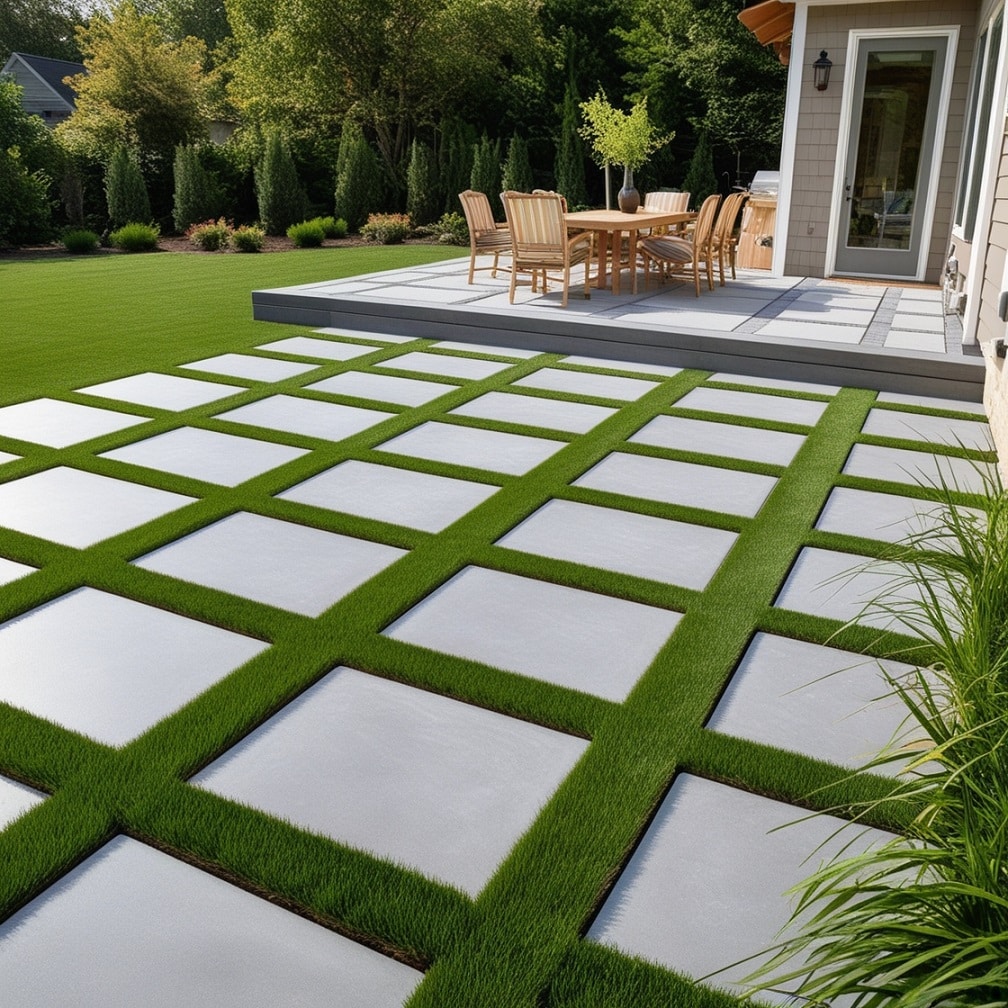
Benefits of concrete and grass patios:
- Increased drainage and reduced runoff
- Cooler surface temperature in hot weather
- Visually striking and unique design
Maintenance tip: Choose a hardy, low-growing grass variety that can withstand foot traffic and requires minimal mowing.
15. Paver and Pebble Combination: Adding Visual and Textural Variety
Create a patio with depth and interest by combining 12×12 pavers with sections of smaller pebbles or gravel. This design is particularly effective for creating distinct zones within your patio area.
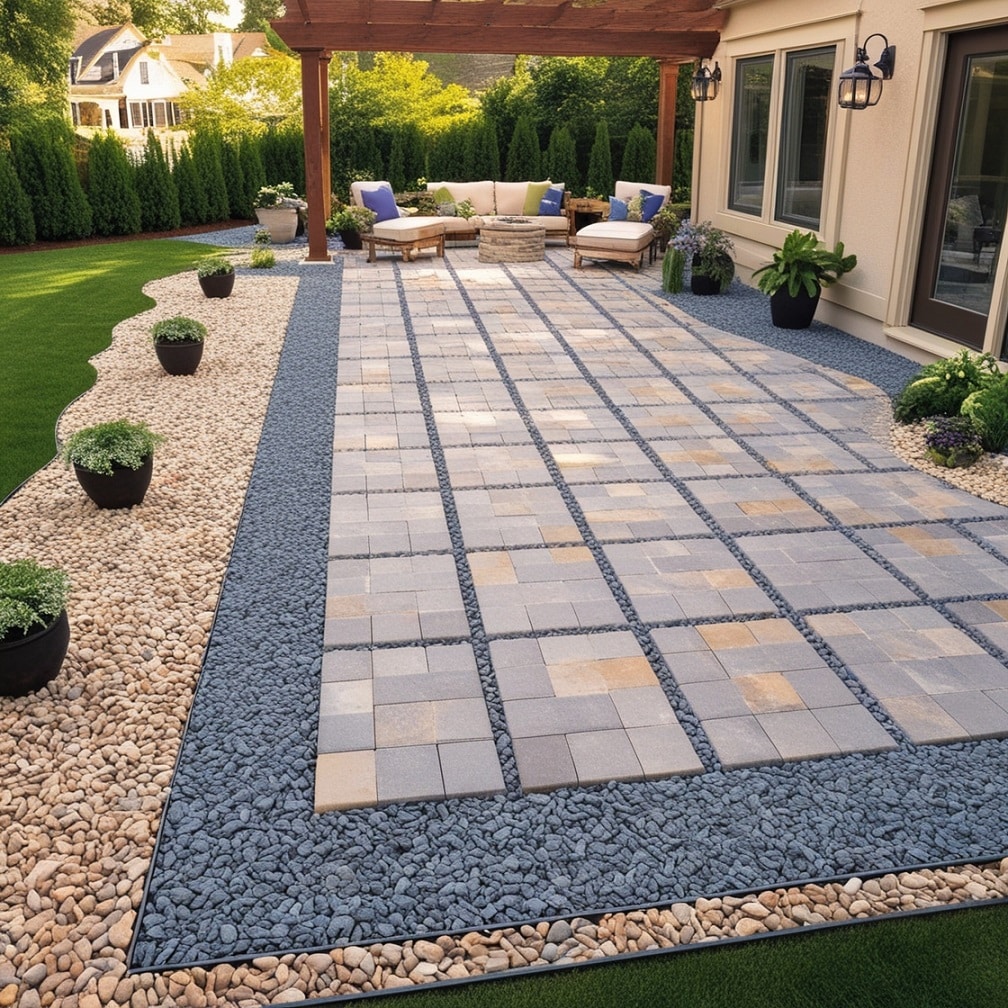
Design ideas:
- Use pebbles to create winding paths between paver sections
- Alternate large square sections of pavers with pebble-filled sections
- Create a pebble border around a central paver patio
Functional Designs
16. Built-in Seating Walls: Maximizing Space in Small Patios
Incorporate built-in seating into your patio design to maximize space and create a cozy atmosphere. This is especially useful for smaller patios where space is at a premium.
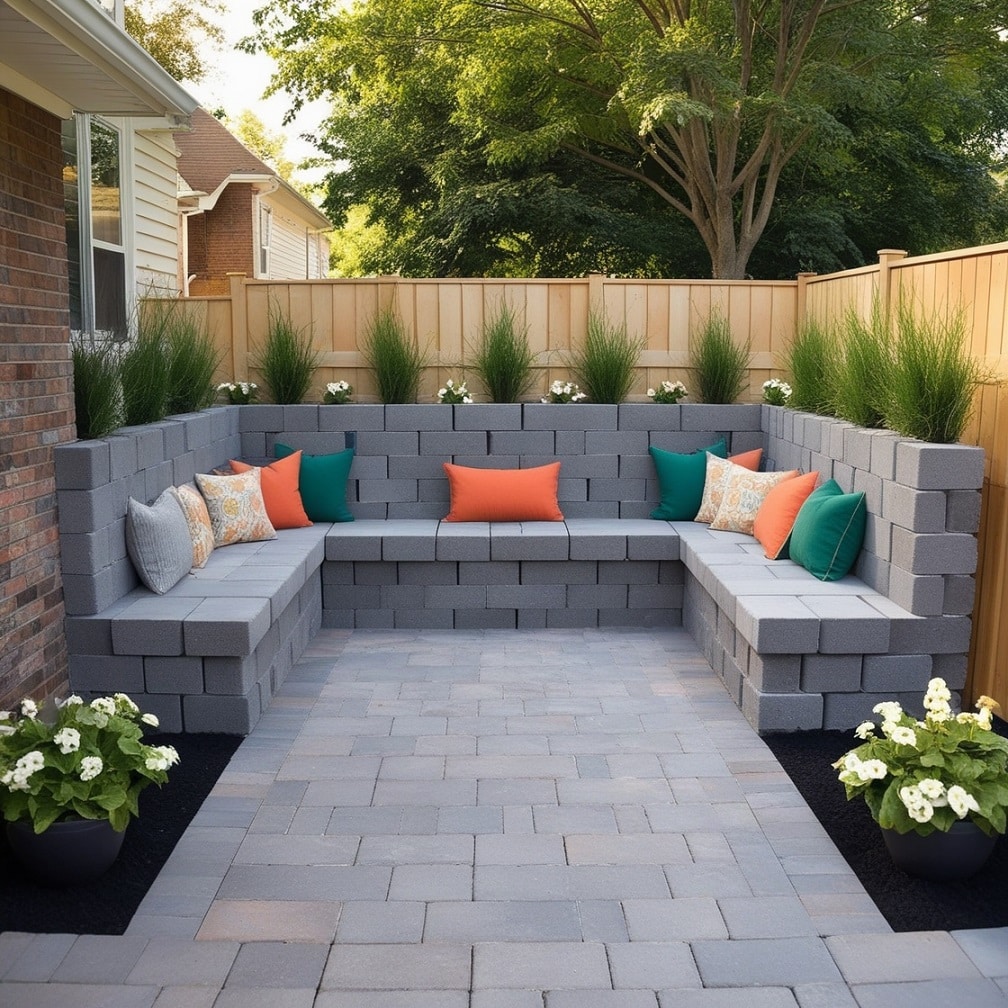
Steps to create built-in seating:
- Plan your seating wall layout
- Build a sturdy base and construct the wall using concrete blocks
- Cap the wall with flat pavers for a comfortable seating surface
- Integrate the seating wall with your 12×12 paver patio design
“Built-in seating not only saves space but also creates a sense of enclosure and intimacy in your outdoor area.” – Lisa Patel, Interior Designer
17. Fire Pit Focus: Creating a Cozy Gathering Spot
A fire pit can serve as the heart of your patio, providing warmth and a focal point for gatherings. Design your 12×12 paver patio around a central fire pit for a cozy and inviting outdoor space.
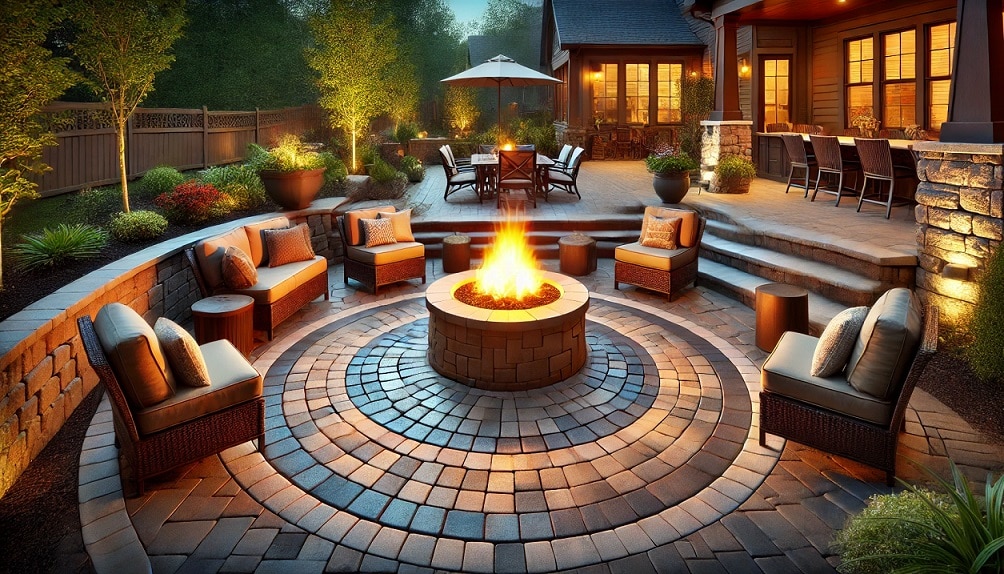
Fire pit patio design tips:
- Create a circular paver pattern radiating from the fire pit
- Use heat-resistant pavers immediately surrounding the fire pit
- Incorporate built-in seating or leave space for movable furniture
Safety note: Always check local regulations regarding fire pit installation and use in residential areas.
Conclusion
In conclusion, your 12×12 paver patio is more than just an outdoor flooring solution it’s a canvas for creativity and a foundation for memorable experiences. Whether you opt for a classic herringbone pattern, an artistic mosaic design, or an innovative game board layout, the key lies in balancing personal style with functionality.
Remember to consider factors like durability, maintenance, and eco-friendliness when making your design choices. Invest in quality materials and don’t shy away from professional help for complex installations.
As you create your perfect outdoor retreat, think long-term and allow room for future adaptations. With thoughtful planning and a touch of imagination, your 12×12 paver patio will not only enhance your home’s value but also provide a beautiful, versatile space for relaxation and entertainment for years to come.

George Martin is a home décor expert and the creative mind behind Home Pedos. With years of experience in transforming spaces, George shares the latest trends, innovative ideas, and practical tips to help you create a home you love. His passion for design is evident in every article, making home styling both accessible and inspiring.